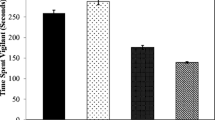Summary
The demographic and ecological characteristics of island populations of small mammals have received increasing attention in recent years, but few studies have compared the behavioral characteristics of island populations with those of mainland populations. Behavior is considered an important variable because it is believed by many to be a crucial factor affecting the population dynamics and demography of natural populations. In particular, among many species of rodents, the social behavior of adults towards juveniles is cited as an important factor influencing dispersal patterns and population regulation. The present study compares social interactions between adults and juveniles of island and mainland populations of the deermouse Peromyscus maniculatus, and attempts to relate differences in behavior to the demographic differences between the two populations. Adult mice were trapped on the mainland of British Columbia and on one of the Gulf Islands off the British Columbia coast, and allowed to breed in the laboratory. Male and female juveniles from both populations were then tested with their own parents and with unrelated male and female adults. The results demonstrate that island adults show almost no aggression towards either own or unrelated young. Mainland adults likewise show little aggression towards their own young, but a proportion of the population, consisting of both male and female adults, shows severe aggression towards unrelated juveniles of both sexes. These results suggest four major conclusions: 1) behavior may be the mechanism responsible for the demographic differences reported for these island and mainland populations; 2) female aggression may be a more important factor in deermouse population dynamics than has been previously recognized; 3) since parents show little aggression towards their own young, adult aggression may be a significant factor in juvenile mortality and emigration only after juveniles have initiated dispersal away from their natal sites; and 4) adult aggression controls the number of both male and female juveniles which are recruited into the population.
Similar content being viewed by others
References
Bekoff M (1977) Mammalian dispersal and the ontogeny of individual behavioral phenotypes. Amer Natur 111:715–732
Boonstra R (1978) Effect of adult Townsend voles (Microtus townsendii) on survival of young. Ecology 59:242–248
Chitty DH (1967) The natural selection of self-regulatory behaviour in animal populations. Ecol Soc Australia, Proc 2:51–78
Eisenberg JF (1968) Behavior patterns. Pp 451–495, In: JA King (ed), Biology of Peromyscus, Spec Publ Amer Soc Mamm
Fairbairn DJ (1977) The spring decline in deermice: death or dispersal? Canad J Zool 55:84–92
Fairbairn DJ (1978 a) Behaviour of dispersing deermice (Peromyscus maniculatus). Behav Ecol Sociobiol 3:265–282
Fairbairn DJ (1978 b) Dispersal of deer mice, Peromyscus maniculatus. Proximal causes and effects on fitness. Oecologia (Berl) 32:171–193
Halpin ZT, Sullivan TP (1978) Social interactions in island and mainland populations of the deermouse Peromyscus maniculatus. J Mamm 59:395–401
Healey MC (1967) Aggression and self-regulation of population size in deermice. Ecology 48:377–392
Herman T (1979) Population ecology of insular Peromyscus maniculatus. Unpublished Ph.D. thesis, University of Alberta, Edmonton
Howard W (1960) Innate and environmental dispersal of individual vertebrates. Amer Midl Natur 63:152–161
Johnson RP (1976) Scent marking with urine in two races of the bank vole Clethrionomys glareolus. Behaviour 55:81–93
Krebs CJ, Gaines MS, Keller BL, Myers JH, Tamarin RH (1973) Population cycles in small rodents. Science 179:35–41
Lidicker WZ (1972) Emigration as a possible mechanism permitting the regulation of population density below carrying capacity. Amer Natur 96:29–33
Lidicker WZ (1973) Regulation of numbers in an island population of the California vole, a problem in community dynamics. Ecol Monogr 43:271–302
Lidicker WZ (1975) The role of dispersal in the demography of small mammals. pp 103–128, In: KG Petrusewicz, FB Golly, L Lyszkowski (eds) Small mammals: productivity and dynamics of populations. Cambridge University Press, 451 pp
Nadeau JH, Lombardi RT, Tamarin RH (1981) Population structure and dispersal of Peromyscus leucopus on Muskeget island. Can J Zool 59:793–799
Petrusewicz KG, Bujalska G, Andrejewski R, Gliwicz J (1971) Productivity processes in an island population of Clethrionomys glareolus. Ann Zool Fennici 8:127–132
Petticrew BG, Sadleir RMFS (1974) The ecology of the deermouse Peromyscus maniculatus in a coastal forest: I. Population dynamics. Canad J Zool 52:107–118
Redfield JA (1975) Distribution, abundance, size, and genetic variation of Peromyscus maniculatus on the Gulf Islands of British Columbia. Canad J Zool 54:463–474
Redfield JA, Taitt MJ, Krebs CJ (1978) Experimental alteration of sex ratios in populations of Microtus townsendii, a field vole. Canad J Zool 56:17–27
Rowley MH, Christian JJ (1976) Intraspecific aggression of Peromyscus leucopus. Behav Biol 17:249–253
Sadleir RMFS (1965) The relationship between agonistic behavior and population changes in the deermouse Peromyscus maniculatus. J Anim Ecol 34:331–352
Savidge IR (1974a) Social factors in the dispersal of deer mice (Peromyscus maniculatus) from their natal site. Amer Midl Natur 91:395–405
Savidge IR (1974b) Maternal aggressiveness and litter survival in deer mice (Peromyscus maniculatus bairdi). Amer Midl Natur 91:449–451
Sullivan TP (1977) Demography and dispersal in island and mainland populations of the deermouse Peromyscus maniculatus. Ecology 58:964–978
Taitt MJ (1978) The dynamics of Peromyscus maniculatus austerus and Microtus townsendii with supplementary food. Unpublished Ph.D. thesis, Univ British Columbia, Vancouver
Tamarin RH (1977) Reproduction in the island beach vole, Microtus breweri, and the mainland meadow vole, Microtus pennsylvanicus, in southeastern Massachusetts. J Mamm 58:536–548
Watson A, Moss R (1970) Dominance, spacing behaviour, and aggression in relation to population limitation in vertebrates. pp 167–218, In: A Watson (ed), Animal populations in relation to their food resources. Blackwell Scientific Publications
Whitsett JM, Gray LE, Bediz GM (1979) Gonadal hormones and aggression toward juvenile conspecifics in prairie deer mice. Behav Ecol Sociobiol 6:165–168
Author information
Authors and Affiliations
Rights and permissions
About this article
Cite this article
Halpin, Z.T. Adult-young interactions in island and mainland populations of the deermouse Peromyscus maniculatus . Oecologia 51, 419–425 (1981). https://doi.org/10.1007/BF00540916
Received:
Issue Date:
DOI: https://doi.org/10.1007/BF00540916




